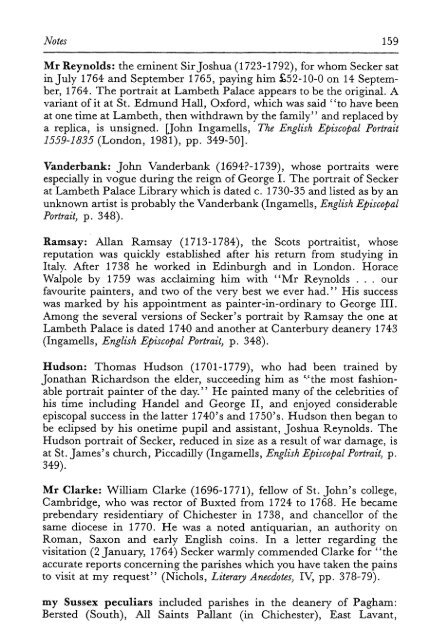Archbishop of Canterbury - KU ScholarWorks - The University of ...
Archbishop of Canterbury - KU ScholarWorks - The University of ...
Archbishop of Canterbury - KU ScholarWorks - The University of ...
You also want an ePaper? Increase the reach of your titles
YUMPU automatically turns print PDFs into web optimized ePapers that Google loves.
Notes 159<br />
Mr Reynolds: the eminent Sir Joshua (1723-1792), for whom Seeker sat<br />
in July 1764 and September 1765, paying him £52-10-0 on 14 September,<br />
1764. <strong>The</strong> portrait at Lambeth Palace appears to be the original. A<br />
variant <strong>of</strong> it at St. Edmund Hall, Oxford, which was said "to have been<br />
at one time at Lambeth, then withdrawn by the family'' and replaced by<br />
a replica, is unsigned. [John Ingamells, <strong>The</strong> English Episcopal Portrait<br />
1559-1835 (London, 1981), pp. 349-50].<br />
Vanderbank: John Vanderbank (1694P-1739), whose portraits were<br />
especially in vogue during the reign <strong>of</strong> George I. <strong>The</strong> portrait <strong>of</strong> Seeker<br />
at Lambeth Palace Library which is dated c. 1730-35 and listed as by an<br />
unknown artist is probably the Vanderbank (Ingamells, English Episcopal<br />
Portrait, p. 348).<br />
Ramsay: Allan Ramsay (1713-1784), the Scots portraitist, whose<br />
reputation was quickly established after his return from studying in<br />
Italy. After 1738 he worked in Edinburgh and in London. Horace<br />
Walpole by 1759 was acclaiming him with "Mr Reynolds . . . our<br />
favourite painters, and two <strong>of</strong> the very best we ever had." His success<br />
was marked by his appointment as painter-in-ordinary to George III.<br />
Among the several versions <strong>of</strong> Seeker's portrait by Ramsay the one at<br />
Lambeth Palace is dated 1740 and another at <strong>Canterbury</strong> deanery 1743<br />
(Ingamells, English Episcopal Portrait, p. 348).<br />
Hudson: Thomas Hudson (1701-1779), who had been trained by<br />
Jonathan Richardson the elder, succeeding him as € *'the most fashionable<br />
portrait painter <strong>of</strong> the day.'' He painted many <strong>of</strong> the celebrities <strong>of</strong><br />
his time including Handel and George II, and enjoyed considerable<br />
episcopal success in the latter 1740's and 1750's. Hudson then began to<br />
be eclipsed by his onetime pupil and assistant, Joshua Reynolds. <strong>The</strong><br />
Hudson portrait <strong>of</strong> Seeker, reduced in size as a result <strong>of</strong> war damage, is<br />
at St. James's church, Piccadilly (Ingamells, English Episcopal Portrait, p.<br />
349).<br />
Mr Clarke: William Clarke (1696-1771), fellow <strong>of</strong> St. John's college,<br />
Cambridge, who was rector <strong>of</strong> Buxted from 1724 to 1768. He became<br />
prebendary residentiary <strong>of</strong> Chichester in 1738, and chancellor <strong>of</strong> the<br />
same diocese in 1770. He was a noted antiquarian, an authority on<br />
Roman, Saxon and early English coins. In a letter regarding the<br />
visitation (2 January, 1764) Seeker warmly commended Clarke for "the<br />
accurate reports concerning the parishes which you have taken the pains<br />
to visit at my request" (Nichols, Literary Anecdotes, IV, pp. 378-79).<br />
my Sussex peculiars included parishes in the deanery <strong>of</strong> Pagham:<br />
Bersted (South), All Saints Pallant (in Chichester), East Lavant,

















